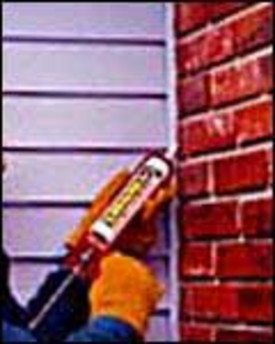 |
|
A bead of caulk can provide big returns on protection by sealing door and window frames, exterior lamps, air conditioners, electrical receptacles and other vulnerable areas on your house. It can also bridge the gap between two building materials, such as where brick or stucco meet wood. Inside the home, caulk keeps water from seeping where sink meets countertop or bathtub meets wall or floor.
Now the big question. Which caulks or sealants work best for specific jobs? With advancements in product technology there are caulks that will provide the best results for just about every job in your house. They are available in colors or even in clear and many can be painted.
The most popular formulation for weather-proofing applications is siliconized acrylic, with excellent adhesion and a tight seal that will last for the lifetime of your home. There are new caulks on the market now that may be used in all temperatures, from as low as 0 degrees Fahrenheit up to 120 degrees F.
A good caulk will adhere to primed and unprimed wood, aluminum, glass, plastic, brick, concrete and many other surfaces. While the basic caulk color is white, many are available in several colors and clear and may be painted after curing.
When applying caulks or sealants on wide gaps up to 1/2 inch width/depth or larger areas, it is best to use a caulking gun![]() with a 10.1 fl. ounce cartridge. The caulk is also available in squeeze tubes for smaller jobs mostly found indoors, such as around sinks and tubs.
with a 10.1 fl. ounce cartridge. The caulk is also available in squeeze tubes for smaller jobs mostly found indoors, such as around sinks and tubs.
Look for points of attack around the house: water leaks, energy loss through doors and window frames, gaps in siding and holes where concrete steps meet wooden porch.
Any old, loose caulk, dirt or debris should be removed with a putty knife![]() . There are several on the market with a sharp end for digging out old material. Cut off the tip of the caulk cartridge on a 45 degree angle with a razor knife
. There are several on the market with a sharp end for digging out old material. Cut off the tip of the caulk cartridge on a 45 degree angle with a razor knife![]() . Mask the area with tape for an even caulk line. Use a fluid, steady motion to lay the bead and smooth with a caulk smoother
. Mask the area with tape for an even caulk line. Use a fluid, steady motion to lay the bead and smooth with a caulk smoother![]() or your finger where necessary. Be careful not to smear the caulk onto the surface or to remove too much of the caulk. Mistakes can be scraped off with a razor knife. The caulk bead should entirely fill the gap and be smooth enough to be virtually unnoticeable.
or your finger where necessary. Be careful not to smear the caulk onto the surface or to remove too much of the caulk. Mistakes can be scraped off with a razor knife. The caulk bead should entirely fill the gap and be smooth enough to be virtually unnoticeable.
Although fall is the most likely time to caulk in preparation for winter weather, it is wise to check the house in the spring to ensure cooling and energy efficiency during the hot summer months. And, keep tabs all year round on vulnerable areas inside the home, such as around sinks, tubs, and toilets. A great deal of water damage can be prevented by a bead of caulk. A variety of caulks and sealants are available at home centers and hardware stores, ranging in price from $2 to $5 — a small price to pay for years of protection against weather and water damage.
Credit: Renovate Your World




























